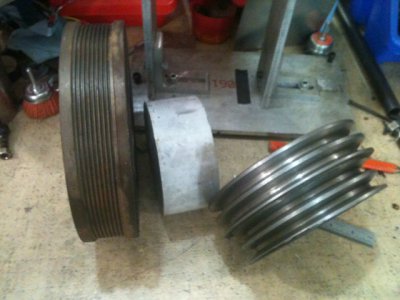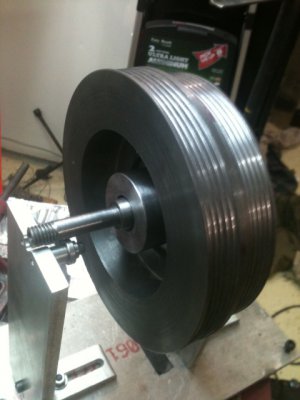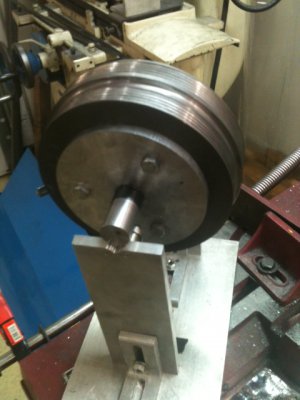- Joined
- Nov 16, 2012
- Messages
- 5,596
Tomorrow I'll finish up all the work on the 1236 and at the last minute, decided to switch the V-belt sheave over to a flat belt. I had a blank piece of cast iron from a flat belt sheave I made a couple years ago that was never picked-up by the customer so, this whole job is being done with "drops" that are laying around. I decided to increase the diameters of the sheave to the extent they'll still fit. The ratios will be preserved of course. It will be a two-piece ordeal because the existing center hole is way too big so I'll make the hub out of aluminum because that's what happens to be laying around.
I haven't looked too closely yet but, there's probably room in the gear area to squeeze in an idler for the flat belt. We'll see...
Here's the old blank sheave, a hunk of aluminum and the two-step sheave from the lathe.

I'm using a 5 groove flat belt and if they're good enough to run a power steering pump and an AC unit which easily sucks up 4-5 HP, it should be good enough for a 2 HP lathe. I left room on the sheave for a 6'th groove if it needs it. Time will tell.
About 3.5 hours later, it's ready for balancing... Oh, please pardon the hex bolts. I didn't have any 5/16" cap screws short enough. I'll get some tomorrow when I pick-up the belt which I calculate should be 34 or 34.5" which is commonly available.


Ray



I haven't looked too closely yet but, there's probably room in the gear area to squeeze in an idler for the flat belt. We'll see...
Here's the old blank sheave, a hunk of aluminum and the two-step sheave from the lathe.

I'm using a 5 groove flat belt and if they're good enough to run a power steering pump and an AC unit which easily sucks up 4-5 HP, it should be good enough for a 2 HP lathe. I left room on the sheave for a 6'th groove if it needs it. Time will tell.
About 3.5 hours later, it's ready for balancing... Oh, please pardon the hex bolts. I didn't have any 5/16" cap screws short enough. I'll get some tomorrow when I pick-up the belt which I calculate should be 34 or 34.5" which is commonly available.


Ray




